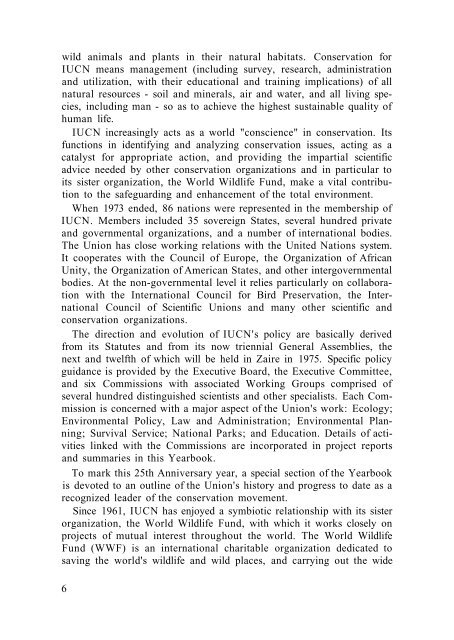1973 iucn yearbook
1973 iucn yearbook
1973 iucn yearbook
Create successful ePaper yourself
Turn your PDF publications into a flip-book with our unique Google optimized e-Paper software.
wild animals and plants in their natural habitats. Conservation for<br />
IUCN means management (including survey, research, administration<br />
and utilization, with their educational and training implications) of all<br />
natural resources - soil and minerals, air and water, and all living species,<br />
including man - so as to achieve the highest sustainable quality of<br />
human life.<br />
IUCN increasingly acts as a world "conscience" in conservation. Its<br />
functions in identifying and analyzing conservation issues, acting as a<br />
catalyst for appropriate action, and providing the impartial scientific<br />
advice needed by other conservation organizations and in particular to<br />
its sister organization, the World Wildlife Fund, make a vital contribution<br />
to the safeguarding and enhancement of the total environment.<br />
When <strong>1973</strong> ended, 86 nations were represented in the membership of<br />
IUCN. Members included 35 sovereign States, several hundred private<br />
and governmental organizations, and a number of international bodies.<br />
The Union has close working relations with the United Nations system.<br />
It cooperates with the Council of Europe, the Organization of African<br />
Unity, the Organization of American States, and other intergovernmental<br />
bodies. At the non-governmental level it relies particularly on collaboration<br />
with the International Council for Bird Preservation, the International<br />
Council of Scientific Unions and many other scientific and<br />
conservation organizations.<br />
The direction and evolution of IUCN's policy are basically derived<br />
from its Statutes and from its now triennial General Assemblies, the<br />
next and twelfth of which will be held in Zaire in 1975. Specific policy<br />
guidance is provided by the Executive Board, the Executive Committee,<br />
and six Commissions with associated Working Groups comprised of<br />
several hundred distinguished scientists and other specialists. Each Commission<br />
is concerned with a major aspect of the Union's work: Ecology;<br />
Environmental Policy, Law and Administration; Environmental Planning;<br />
Survival Service; National Parks; and Education. Details of activities<br />
linked with the Commissions are incorporated in project reports<br />
and summaries in this Yearbook.<br />
To mark this 25th Anniversary year, a special section of the Yearbook<br />
is devoted to an outline of the Union's history and progress to date as a<br />
recognized leader of the conservation movement.<br />
Since 1961, IUCN has enjoyed a symbiotic relationship with its sister<br />
organization, the World Wildlife Fund, with which it works closely on<br />
projects of mutual interest throughout the world. The World Wildlife<br />
Fund (WWF) is an international charitable organization dedicated to<br />
saving the world's wildlife and wild places, and carrying out the wide<br />
6

















